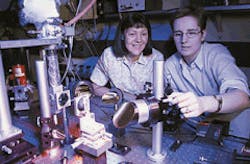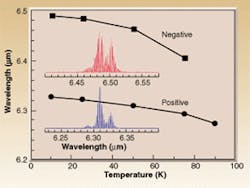QUANTUM CASCADE LASERS: Bidirectional laser emits two wavelengths

Made up of many layers that form a multiple quantum-well structure, a QC laser emits at a wavelength determined by its layer thicknesses rather than by the gain material. The bidirectional laser consists of 17 layers that alternate in composition between aluminum indium arsenide and gallium indium arsenide. Contained in the structure are two active regions separated by 35 nm and sandwiching an injector region. Under a positive bias, the injector causes one active region to emit; under a negative bias, the other active region emits. If the two active regions are made so that they are not identical in layer structure, then light at two differing wavelengths is the result, emitted independently of each other and separated in time. Because the prototype lasers operate best at temperatures below 150 K, they are mounted on the cold finger of a helium flow cryostat. The lasers produce 50-ns pulses at up to a 100-kHz repetition rate, with peak power reaching 300 mW.
A representative nonsymmetric bidirectional laser emits a TEM00 beam at either 6.33 or 6.50 µm. The researchers have also built symmetric bidirectional lasers in which the two outputs have identical wavelength. This design demonstrates that, unlike other multiwavelength semiconductor light sources, arbitrarily close emission wavelengths are possible in the bidirectional device—eliminating restrictions that might limit certain spectroscopic applications.
The optical transition in a QC laser takes place between quantized states in the conduction band rather than between the conduction and valence bands as in a conventional diode laser. This fact gives rise to some interesting properties, such as a switching time between wavelengths of only 70 ps, according to Gmachl. So far, the bidirectional laser emits only to 175 K, but Gmachl says that room temperature is expected, as has been achieved with standard QC lasers. Continuous-wave operation at room temperature is also feasible, she adds.
Used for differential absorption light detection and ranging, the bidirectional laser will emit at a wavelength in resonance with a particular trace gas, then almost instantaneously at an off-resonance wavelength, replacing the traditional two-laser setup. Gmachl describes two applications for the laser in free-space optical communications. In the first, when the data stream is dense, the laser switches continuously between wavelengths, providing complementary data sets, one serving as the backup for the other. In the second, when the data stream is sparse, the laser becomes the equivalent of a wavelength-division-multiplexing device, producing two independent data streams of differing wavelengths.
About the Author
John Wallace
Senior Technical Editor (1998-2022)
John Wallace was with Laser Focus World for nearly 25 years, retiring in late June 2022. He obtained a bachelor's degree in mechanical engineering and physics at Rutgers University and a master's in optical engineering at the University of Rochester. Before becoming an editor, John worked as an engineer at RCA, Exxon, Eastman Kodak, and GCA Corporation.

